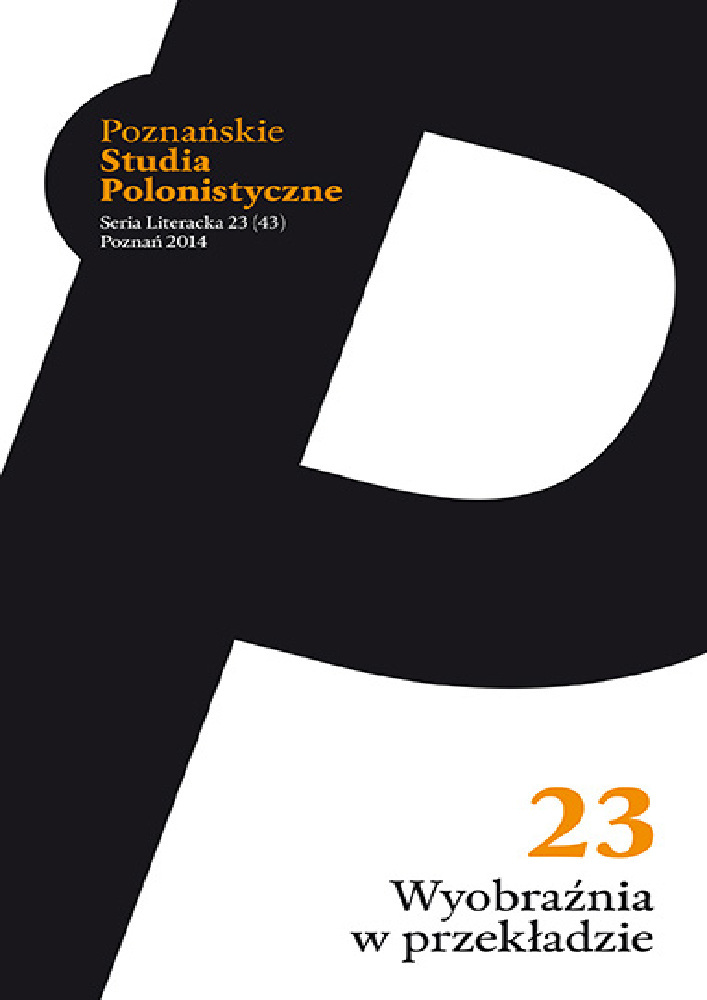Abstract
Pan Kiehot by Günter Grass is one of many literary incarnations of Cervantes’s Don Quijote. Grass created his hero in a double manner: the character exists in the poem Pan Kiehot, published in Gleisdreieck in 1960, and a fragment of a chapter in The Tin Drum, the novel published in 1959. The poem has been translated six times into Polish, by Jan Koprowski, Krzysztof Karasek, Bolesław Fac, Zdzisław Jaskuła, Wojciech Woźniak and Ryszard Sobieszczański), whereas The Tin Drum, only once, by Sławomir Błaut. The article analyses all the translations into Polish, as well as the translation into Kashubian by Jan Trepczyk, in the context of the notion of translation series and textualisation series, proposed by Marta Skwara, and with reference to theorists of quixotism, such as Arne Melberg, Josè Ortega y Gasset and Michel Foucault, as well as to German and Polish critics of Grass’s work. The author draws conclusions about the challenge of a different form of interpretation, multiplied interpretation, which is facing the reader of a translation or textualisation series. Every translator who works on a text that has been translated before, must face various anxieties: “the anxiety of influence”, which is often coupled by horror vacui, and fear of imperfect rendition of source-texts meanings (as described by Jerzy Jarniewicz). Thanks to translation series, and works that constitute textualisation series together with translations, Grass’s Pan Kiehot is inscribed in entirely new interpretative framework: each new translation, thus, constitutes a challenge for the translator and for the imagination of a reader of the series.References
Bloom H., Lęk przed wpływem. Teoria poezji, tłum. A Bielik-Robson, Kraków 2002.
Błaut S., Polak tłumaczy Grassa, w: Janion M., Günter Grass i polski Pan Kichot, Gdańsk 1999.
Cervantes Saavedra M. de, Przemyślny szlachcic Don Kichote z Manczy, tłum. A. i Z. Czerny, Warszawa 1972.
Engels B., Das lyrische Umfeld der „Danziger Trilogie” von Günter Grass, Würzburg 2005.
Fac B., Emigration, w: idem, Gedichte, Gdańsk 1995.
Fac B., Przed dwukropkiem poszukuje się posłusznych słów, w: G. Grass, Wiersze wybrane, Gdańsk 1986.
Foucault M., Słowa i rzeczy, tłum. T. Komendant, Gdańsk 2006.
Gołąbk E., Kaszëbsczi słowôrz normatiwny, Gdańsk 2005.
Grass G., Blaszany bębenek, tłum. S. Błaut, Kraków 2004.
Grass G., Die Blechtrommel, München 2005.
Grass G., Wiersze wybrane, wybór, oprac., posłowie B. Fac, Gdańsk 1986.
Hamburger M., Moralist mit Narrenkappe. Die Lyrik des Günter Grass, „Text + Kritik”, z. 1/1a: Günter Grass.
Honsza N., Güntera Grassa portret własny, Wrocław 2000.
Janion M., Günter Grass i polski Pan Kichot, Gdańsk 1999.
Jarniewicz J., Horror vacui, czyli polityka nadmiaru w przekładzie, w: idem, Gościnność słowa. Szkice o przekładzie literackim, Kraków 2012.
Kaszyński S.H., Die Polengedichte von Günter Grass, „Studia Germanica Posnaniensia” 1983, t. 12.
Koprowski J., Do Güntera Grassa, w: Wiersze z podróży, Łódź 1989.
Krolow K., Günter Grass in seinen Gedichten, w: Grass. Kritik – Thesen–Analysen, red. M. Jurgensen, Bern – München 1973.
Krysztofiak M., Polnische Symbolik und Metaphorik in den Gedichten von Günter Grass und ihre Widerspiegelung in den polnischen Übersetzungen, w: Übersetzen, verstehen, Brücken bauen: geisteswissenschaftliches und literarisches Übersetzen im internationalen Kulturaustausch, red. A.P. Frank, Berlin 1993.
Melberg A., Teorie mimesis: repetycja, tłum. J. Balbierz, Kraków 2002.
Ortega y Gasset J., Medytacje o „Don Kichocie”, tłum. J. Wojcieszak, Warszawa 2008.
Ramułt S., Słownik języka pomorskiego, czyli kaszubskiego, scalił i znormalizował J. Treder, według wydań Akademii Umiejętności z roku 1893 i Polskiej Akademii Umiejętności z roku 1993, Gdańsk 2006.
Skwara M., Wyobraźnia badacza – od serii przekładowej do serii recepcyjnej, „Poznańskie Studia Polonistyczne. Seria Literacka”, nr 23 (43), Poznań 2014.
Stolz D., Günter Grass. Der Schriftsteller. Eine Einführung, Göttingen 2005.
Sychta B., Słowniki gwar kaszubskich na tle kultury ludowej, t. 4, Wrocław 1970.
Światłowski Z., Portret z bębenkiem i ślimakiem, Gdańsk 2000.
Trepczyk J., Słownik polsko-kaszubski, oprac. naukowe, aneks J. Treder, Gdańsk 1994, t. 1.
Trepczyk J., Słownik polsko-kaszubski, oprac. naukowe, aneks J. Treder, Gdańsk 1994, t. 2.
License
Authors
Authors of texts accepted for publication in „Poznańskie Studia Polonistyczne. Seria Literacka” are required to complete, sign and return to the editor's office the Agreement for granting a royalty-free license to works with a commitment to grant a CC sub-license.
Under the agreement, the authors of texts published in „Poznańskie Studia Polonistyczne. Seria Literacka” grant the Adam Mickiewicz University in Poznań a non-exclusive, royalty-free license and authorize the use of Attribution-NoDerivatives 4.0 International (CC BY-ND 4.0)Creative Commons sub-license.
The authors retain the right to continue the free disposal of the work.
Users
Interested Internet users are entitled to use works published in „Poznańskie Studia Polonistyczne. Seria Literacka” since 2016, for non-commercial purposes only, under the following conditions:
- attribution - obligation to provide, together with the distributed work, information about the authorship, title, source (link to the original work, DOI) and the license itself.
- no derivatives - the work must be preserved in its original form, without the author's consent it is not possible to distribute the modified work, such as translations, publications, etc.
Copyrights are reserved for all texts published before 2016.
Miscellaneous
Adam Mickiewicz University in Poznań retains the right to magazines as a whole (layout, graphic form, title, cover design, logo etc.).
